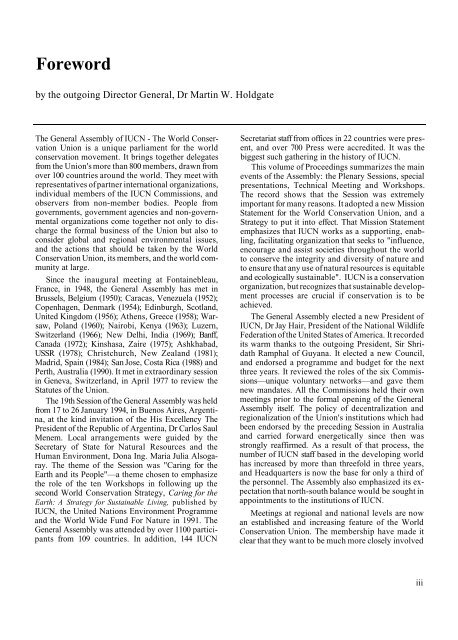Buenos Aires, Argentina - IUCN
Buenos Aires, Argentina - IUCN
Buenos Aires, Argentina - IUCN
You also want an ePaper? Increase the reach of your titles
YUMPU automatically turns print PDFs into web optimized ePapers that Google loves.
Foreword<br />
by the outgoing Director General, Dr Martin W. Holdgate<br />
The General Assembly of <strong>IUCN</strong> - The World Conservation<br />
Union is a unique parliament for the world<br />
conservation movement. It brings together delegates<br />
from the Union's more than 800 members, drawn from<br />
over 100 countries around the world. They meet with<br />
representatives of partner international organizations,<br />
individual members of the <strong>IUCN</strong> Commissions, and<br />
observers from non-member bodies. People from<br />
governments, government agencies and non-governmental<br />
organizations come together not only to discharge<br />
the formal business of the Union but also to<br />
consider global and regional environmental issues,<br />
and the actions that should be taken by the World<br />
Conservation Union, its members, and the world community<br />
at large.<br />
Since the inaugural meeting at Fontainebleau,<br />
France, in 1948, the General Assembly has met in<br />
Brussels, Belgium (1950); Caracas, Venezuela (1952);<br />
Copenhagen, Denmark (1954); Edinburgh, Scotland,<br />
United Kingdom (1956); Athens, Greece (1958); Warsaw,<br />
Poland (1960); Nairobi, Kenya (1963); Luzern,<br />
Switzerland (1966); New Delhi, India (1969); Banff,<br />
Canada (1972); Kinshasa, Zaire (1975); Ashkhabad,<br />
USSR (1978); Christchurch, New Zealand (1981);<br />
Madrid, Spain (1984); San Jose, Costa Rica (1988) and<br />
Perth, Australia (1990). It met in extraordinary session<br />
in Geneva, Switzerland, in April 1977 to review the<br />
Statutes of the Union.<br />
The 19th Session of the General Assembly was held<br />
from 17 to 26 January 1994, in <strong>Buenos</strong> <strong>Aires</strong>, <strong>Argentina</strong>,<br />
at the kind invitation of the His Excellency The<br />
President of the Republic of <strong>Argentina</strong>, Dr Carlos Saul<br />
Menem. Local arrangements were guided by the<br />
Secretary of State for Natural Resources and the<br />
Human Environment, Dona Ing. Maria Julia Alsogaray.<br />
The theme of the Session was "Caring for the<br />
Earth and its People"—a theme chosen to emphasize<br />
the role of the ten Workshops in following up the<br />
second World Conservation Strategy, Caring for the<br />
Earth: A Strategy for Sustainable Living, published by<br />
<strong>IUCN</strong>, the United Nations Environment Programme<br />
and the World Wide Fund For Nature in 1991. The<br />
General Assembly was attended by over 1100 participants<br />
from 109 countries. In addition, 144 <strong>IUCN</strong><br />
Secretariat staff from offices in 22 countries were present,<br />
and over 700 Press were accredited. It was the<br />
biggest such gathering in the history of <strong>IUCN</strong>.<br />
This volume of Proceedings summarizes the main<br />
events of the Assembly: the Plenary Sessions, special<br />
presentations, Technical Meeting and Workshops.<br />
The record shows that the Session was extremely<br />
important for many reasons. It adopted a new Mission<br />
Statement for the World Conservation Union, and a<br />
Strategy to put it into effect. That Mission Statement<br />
emphasizes that <strong>IUCN</strong> works as a supporting, enabling,<br />
facilitating organization that seeks to "influence,<br />
encourage and assist societies throughout the world<br />
to conserve the integrity and diversity of nature and<br />
to ensure that any use of natural resources is equitable<br />
and ecologically sustainable". <strong>IUCN</strong> is a conservation<br />
organization, but recognizes that sustainable development<br />
processes are crucial if conservation is to be<br />
achieved.<br />
The General Assembly elected a new President of<br />
<strong>IUCN</strong>, Dr Jay Hair, President of the National Wildlife<br />
Federation of the United States of America. It recorded<br />
its warm thanks to the outgoing President, Sir Shridath<br />
Ramphal of Guyana. It elected a new Council,<br />
and endorsed a programme and budget for the next<br />
three years. It reviewed the roles of the six Commissions—unique<br />
voluntary networks—and gave them<br />
new mandates. All the Commissions held their own<br />
meetings prior to the formal opening of the General<br />
Assembly itself. The policy of decentralization and<br />
regionalization of the Union's institutions which had<br />
been endorsed by the preceding Session in Australia<br />
and carried forward energetically since then was<br />
strongly reaffirmed. As a result of that process, the<br />
number of <strong>IUCN</strong> staff based in the developing world<br />
has increased by more than threefold in three years,<br />
and Headquarters is now the base for only a third of<br />
the personnel. The Assembly also emphasized its expectation<br />
that north-south balance would be sought in<br />
appointments to the institutions of <strong>IUCN</strong>.<br />
Meetings at regional and national levels are now<br />
an established and increasing feature of the World<br />
Conservation Union. The membership have made it<br />
clear that they want to be much more closely involved<br />
iii












